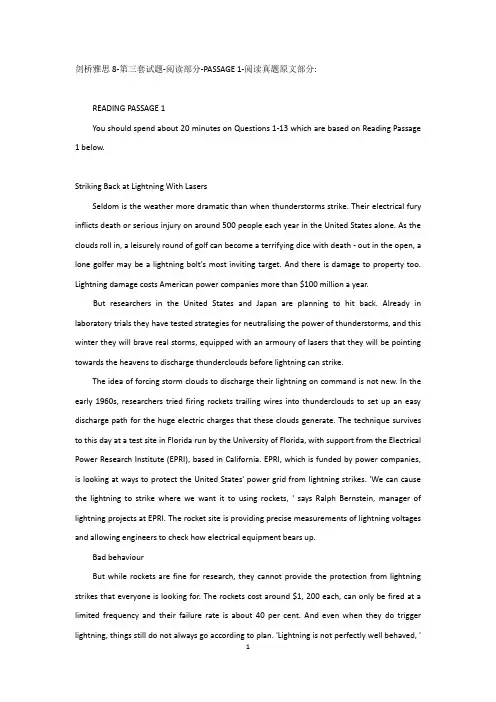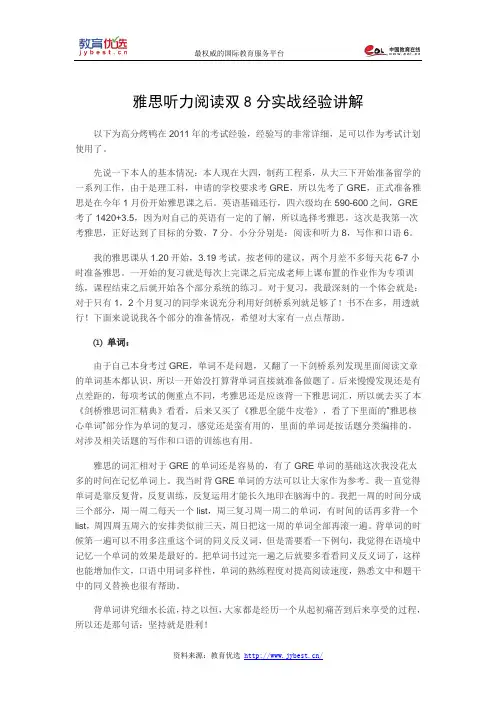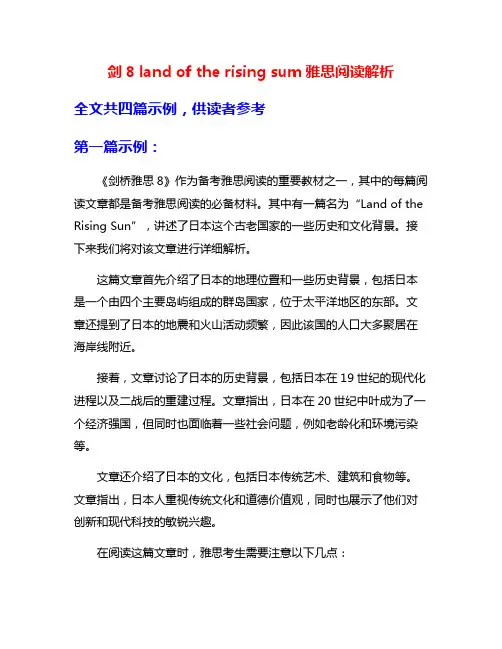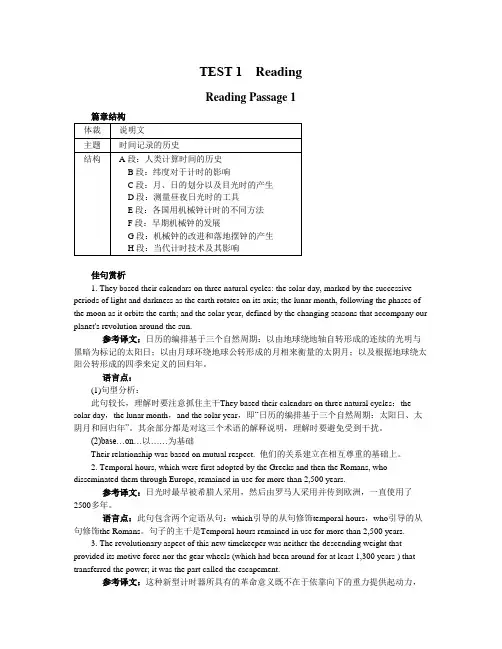雅思精讲阅读班精讲班第8讲讲义
- 格式:pdf
- 大小:115.33 KB
- 文档页数:3


剑桥雅思8-第三套试题-阅读部分-PASSAGE 1-阅读真题原文部分:READING PASSAGE 1You should spend about 20 minutes on Questions 1-13 which are based on Reading Passage 1 below.Striking Back at Lightning With LasersSeldom is the weather more dramatic than when thunderstorms strike. Their electrical fury inflicts death or serious injury on around 500 people each year in the United States alone. As the clouds roll in, a leisurely round of golf can become a terrifying dice with death - out in the open, a lone golfer may be a lightning bolt's most inviting target. And there is damage to property too. Lightning damage costs American power companies more than $100 million a year.But researchers in the United States and Japan are planning to hit back. Already in laboratory trials they have tested strategies for neutralising the power of thunderstorms, and this winter they will brave real storms, equipped with an armoury of lasers that they will be pointing towards the heavens to discharge thunderclouds before lightning can strike.The idea of forcing storm clouds to discharge their lightning on command is not new. In the early 1960s, researchers tried firing rockets trailing wires into thunderclouds to set up an easy discharge path for the huge electric charges that these clouds generate. The technique survives to this day at a test site in Florida run by the University of Florida, with support from the Electrical Power Research Institute (EPRI), based in California. EPRI, which is funded by power companies, is looking at ways to protect the United States' power grid from lightning strikes. 'We can cause the lightning to strike where we want it to using rockets, ' says Ralph Bernstein, manager of lightning projects at EPRI. The rocket site is providing precise measurements of lightning voltages and allowing engineers to check how electrical equipment bears up.Bad behaviourBut while rockets are fine for research, they cannot provide the protection from lightning strikes that everyone is looking for. The rockets cost around $1, 200 each, can only be fired at a limited frequency and their failure rate is about 40 per cent. And even when they do trigger lightning, things still do not always go according to plan. 'Lightning is not perfectly well behaved, 'says Bernstein. 'Occasionally, it will take a branch and go someplace it wasn't supposed to go. ' And anyway, who would want to fire streams of rockets in a populated area? 'What goes up must come down, ' points out Jean-Claude Diels of the University of New Mexico. Diels is leading a project, which is backed by EPRI, to try to use lasers to discharge lightning safely - and safety is a basic requirement since no one wants to put themselves or their expensive equipment at risk. With around $500, 000 invested so far, a promising system is just emerging from the laboratory.The idea began some 20 years ago, when high-powered lasers were revealing their ability to extract electrons out of atoms and create ions. If a laser could generate a line of ionisation in the air all the way up to a storm cloud, this conducting path could be used to guide lightning to Earth, before the electric field becomes strong enough to break down the air in an uncontrollable surge. To stop the laser itself being struck, it would not be pointed straight at the clouds. Instead it would be directed at a mirror, and from there into the sky. The mirror would be protected by placing lightning conductors close by. Ideally, the cloud-zapper (gun)would be cheap enough to be installed around all key power installations, and portable enough to be taken to international sporting events to beam up at brewing storm clouds.A stumbling blockHowever, there is still a big stumbling block. The laser is no nifty portable: it's a monster that takes up a whole room. Diels is trying to cut down the size and says that a laser around the size of a small table is in the offing. He plans to test this more manageable system on live thunderclouds next summer.Bernstein says that Diels's system is attracting lots of interest from the power companies. But they have not yet come up with the $5 million that EPRI says will be needed to develop a commercial system, by making the lasers yet smaller and cheaper. 'I cannot say I have money yet, but I'm working on it, ' says Bernstein. He reckons that the forthcoming field tests will be the turning point - and he's hoping for good news. Bernstein predicts 'an avalanche of interest and support' if all goes well. He expects to see cloud-zappers eventually costing 100, 000 each.Other scientists could also benefit. With a lightning 'switch' at their fingertips, materials scientists could find out what happens when mighty currents meet matter. Diels also hopes to see the birth of 'interactive meteorology' - not just forecasting the weather but controlling it. 'If we could discharge clouds, we might affect the weather, ' he says.And perhaps, says Diels, we'll be able to confront some other meteorological menaces. 'We think we could prevent hail by inducing lightning, ' he says. Thunder, the shock wave that comes from a lightning flash, is thought to be the trigger for the torrential rain that is typical of storms. A laser thunder factory could shake the moisture out of clouds, perhaps preventing the formation of the giant hailstones that threaten crops. With luck, as the storm clouds gather this winter, laser-toting researchers could, for the first time, strike back.Questions 1-3Choose the correct letter, A, B, C or D.Write the correct letter in boxes 1-3 on your answer sheet.1 The main topic discussed in the text isA the damage caused to US golf courses and golf players by lightning strikes.B the effect of lightning on power supplies in the US and in Japan.C a variety of methods used in trying to control lightning strikes.D a laser technique used in trying to control lightning strikes.2 According to the text, every year lightningA does considerable damage to buildings during thunderstorms.B kills or injures mainly golfers in the United States.C kills or injures around 500 people throughout the world.D damages more than 100 American power companies.3 Researchers at the University of Florida and at the University of New MexicoA receive funds from the same source.B are using the same techniques.C are employed by commercial companies.D are in opposition to each other.Questions 4-6Complete the sentences below.Choose NO MORE THAN TWO WORDS from the passage for each answer.Write your answers in boxes 4-6 on your answer sheet.4 EPRI receives financial support from………………………….5 The advantage of the technique being developed by Diels is that it can be used……………….6 The main difficulty associated with using the laser equipment is related to its……………….Questions 7-10Complete the summary using the list of words, A-I, below.Write the correct letter, A-I, in boxes 7-10 on your answer sheet.In this method, a laser is used to create a line of ionisation by removing electrons from 7 …………………………. This laser is then directed at 8 …………………………in order to control electrical charges, a method which is less dangerous than using 9 …………………………. As a protection for the lasers, the beams are aimed firstly at 10………………………….A cloud-zappersB atomsC storm cloudsD mirrorsE techniqueF ionsG rockets H conductors I thunderQuestions 11-13Do the following statements agree with the information given in Reading Passage 1?In boxes 11-13 on your answer sheet writeYES if the statement agrees with the claims of the writerNO if the statement contradicts the claims of the writerNOT GIVEN if it is impossible to say what the writer thinks about this11 Power companies have given Diels enough money to develop his laser.12 Obtaining money to improve the lasers will depend on tests in real storms.13 Weather forecasters are intensely interested in Diels's system.READING PASSAGE 1篇章结构体裁说明文主题用激光回击闪电结构第1段:闪电带来的危害第2段:科研人员正在研究回击闪电的方法第3段:先前的闪电回击术介绍第4段:火箭回击术的缺陷第5段:更安全的激光回击术第6段:激光回击术的技术原理第7段:激光回击术的缺陷第8段:通过实地实验改进激光回击术第9段:激光回击术对其他学科也有益处第10段:激光回击术的其他用途解题地图难度系数:★★★解题顺序:按题目顺序解答即可友情提示:烤鸭们注意:本文中的SUMMARY题目顺序有改变,解题要小心;MULTIPLE CHOICE的第三题是个亮点,爱浮想联翩的烤鸭们可能会糊掉。





雅思5.5根底阅读课程讲义UNIT 1 Education (3)UNIT 2 Food (5)UNIT 3 Health (8)UNIT 4 Media (10)Locating Information (15)UNIT 5 Practice 1 (18)UNIT 6 Advertising (20)UNIT 7 Learning to Speak (29)Summary Completion (31)UNIT 8 The Environment (31)Short Answers (34)UNIT 9 Sponsorship in Sport (34)UNIT 10 Practice 2 (39)Flowchart-Timeline Completion (41)UNIT 11 Transport (41)UNIT 12 Travel (49)UNIT 13 Technology (56)Labelling a Diagram (58)Unit14 Money (59)UNIT 15 Practice 3 (66)Multiple Choice (68)Labelling a Diagram (71)UNIT 17 Social Issues (72)IELTS Type Questions: Reading: for Details and for Main Ideas (74)Table Completion (74)UNIT 20 Practice 4 (80)Note Completion (82)UNIT 1 EducationEducation over the past 100 yearsAThe education of our young people is one of the most important aspects of any community, and ideas about what and how to teach reflect the accepted attitudes and unspoken beliefs of society. These ideas change as local customs and attitudes change, and these changes are reflected in the curriculum, teaching and assessment methods and the expectations of how both students and teachers should behave.词汇讲解:curriculum n. 教学大纲;reflect v. 反映;反射;assessment n. 评价;BTeaching in the late 1800s and early 1900s was very different from today. Rules for teachers at the time in the USA covered both the teacher's duties and their conduct out of class as well. Teachers at that time were expected to set a good example to their pupils and to behave in a very virtuous and proper manner. Women teachers should not marry, nor shou ld they ‘keep company with men.' They had to wear long dresses and no bright colours and they were not permitted to dye their hair. They were not allowed to loiter downtown in an ice cream store, and women were not allowed to go out in the evenings unless to a school function, although men were allowed one evening a week to take their girlfriends out if they went to church regularly. No teachers were allowed to drink alcohol. They were allowed to read only good books such as the Bible, and they were given a pay increase of 25c a week after five years of work for the local school.词汇讲解:manner n. 行为守那么;be expected to:被预期…表示将来时:be expected tobe predicted tobe perspective toCAs well as this long list of ‘dos' and ‘don'ts,' teachers had certain duties to perform each day. In country schools, teachers were required to keep the coal bucket full for the classroom fire, and to bring a bucket of water each day for the children to drink. They had to make the pens for their students to write with and to sweep the floor and keep the classroom tidy. However, despite this list of duties, little was stipulated about the content of the teaching, nor about assessment methods.DTeachers would have been expected to teach the three ‘r’s—reading, writing and arithmetic, and to teach the children about Christianity and read from the Bible every day. Education in those days was much simpler than it is today and covered basic literacy skills and religious education. They would almost certainly have used corporal punishment such as a stick or the strap on naughty or unruly children, and the children would have sat together in pairs in long rows in the classroom. They would have been expected to sit quietly and to do their work, copying long rows of letters or doing basic maths sums. Farming children in country areas would have had only a few years of schooling and would probably have left school at 12 or 14 years of age to join their parents in farm work.词汇讲解:arithmetic:算数;literacy:文学,阅读;religious:的;discrimination:歧视;religious discrimination:歧视。


雅思听力阅读双8分实战经验讲解以下为高分烤鸭在2011年的考试经验,经验写的非常详细,足可以作为考试计划使用了。
先说一下本人的基本情况:本人现在大四,制药工程系,从大三下开始准备留学的一系列工作,由于是理工科,申请的学校要求考GRE,所以先考了GRE,正式准备雅思是在今年1月份开始雅思课之后。
英语基础还行,四六级均在590-600之间,GRE 考了1420+3.5,因为对自己的英语有一定的了解,所以选择考雅思,这次是我第一次考雅思,正好达到了目标的分数,7分。
小分分别是:阅读和听力8,写作和口语6。
我的雅思课从1.20开始,3.19考试。
按老师的建议,两个月差不多每天花6-7小时准备雅思。
一开始的复习就是每次上完课之后完成老师上课布置的作业作为专项训练,课程结束之后就开始各个部分系统的练习。
对于复习,我最深刻的一个体会就是:对于只有1,2个月复习的同学来说充分利用好剑桥系列就足够了!书不在多,用透就行!下面来说说我各个部分的准备情况,希望对大家有一点点帮助。
⑴单词:由于自己本身考过GRE,单词不是问题,又翻了一下剑桥系列发现里面阅读文章的单词基本都认识,所以一开始没打算背单词直接就准备做题了。
后来慢慢发现还是有点差距的,每项考试的侧重点不同,考雅思还是应该背一下雅思词汇,所以就去买了本《剑桥雅思词汇精典》看看,后来又买了《雅思全能牛皮卷》,看了下里面的“雅思核心单词”部分作为单词的复习,感觉还是蛮有用的,里面的单词是按话题分类编排的,对涉及相关话题的写作和口语的训练也有用。
雅思的词汇相对于GRE的单词还是容易的,有了GRE单词的基础这次我没花太多的时间在记忆单词上。
我当时背GRE单词的方法可以让大家作为参考。
我一直觉得单词是靠反复背,反复训练,反复运用才能长久地印在脑海中的。
我把一周的时间分成三个部分,周一周二每天一个list,周三复习周一周二的单词,有时间的话再多背一个list,周四周五周六的安排类似前三天,周日把这一周的单词全部再滚一遍。

剑8 land of the rising sum雅思阅读解析全文共四篇示例,供读者参考第一篇示例:《剑桥雅思8》作为备考雅思阅读的重要教材之一,其中的每篇阅读文章都是备考雅思阅读的必备材料。
其中有一篇名为“Land of the Rising Sun”,讲述了日本这个古老国家的一些历史和文化背景。
接下来我们将对该文章进行详细解析。
这篇文章首先介绍了日本的地理位置和一些历史背景,包括日本是一个由四个主要岛屿组成的群岛国家,位于太平洋地区的东部。
文章还提到了日本的地震和火山活动频繁,因此该国的人口大多聚居在海岸线附近。
接着,文章讨论了日本的历史背景,包括日本在19世纪的现代化进程以及二战后的重建过程。
文章指出,日本在20世纪中叶成为了一个经济强国,但同时也面临着一些社会问题,例如老龄化和环境污染等。
文章还介绍了日本的文化,包括日本传统艺术、建筑和食物等。
文章指出,日本人重视传统文化和道德价值观,同时也展示了他们对创新和现代科技的敏锐兴趣。
在阅读这篇文章时,雅思考生需要注意以下几点:要熟悉日本的地理位置和历史背景,了解该国的基本情况。
这有助于更好地理解文章内容。
要关注文章中提到的日本社会问题,例如老龄化和环境污染等。
这些问题可能会成为雅思阅读考试的话题之一。
要留意文章中提到的日本文化和传统价值观。
这些内容可能会涉及到雅思口语和写作考试中的话题。
要注意文章中的主题和作者观点,分析文章的结构以及作者的意图。
这有助于帮助考生更好地理解文章,并在考试中更好地回答问题。
《剑8 Land of the Rising Sun》这篇文章无论是从地理、历史还是文化方面都是备考雅思阅读的重要材料。
考生可以通过阅读和解析这篇文章,提高自己的阅读能力和应对考试的能力。
希望考生们能够在备考雅思阅读时充分利用这个资源,取得满意的成绩。
第二篇示例:雅思阅读是备考雅思考生们最头疼的部分之一,尤其是对于英语能力稍显一般的考生来说,想要在阅读部分取得一个好成绩,就需要花费更多的时间和精力去准备。

TEST 1 ReadingReading Passage 1篇章结构佳句赏析1. They based their calendars on three natural cycles: the solar day, marked by the successive periods of lightand darkness as the earth rotates on its axis; the lunar month, following the phases of the moon as it orbits the earth; and the solar year, defined by the changing seasons that accompany our planet's revolution around the sun.·参考译文:日历的编排基于三个自然周期:以由地球绕地轴自转形成的连续的光明与黑暗为标记的太阳日;以由月球环绕地球公转形成的月相来衡量的太阴月;以及根据地球绕太阳公转形成的四季来定义的回归年。
·语言点:(1)句型分析:此句较长,理解时要注意抓住主干They based their calendars on three natural cycles:the solarday,the lunar month,and the solar year,即“日历的编排基于三个自然周期:太阳日、太阴月和回归年”。
其余部分都是对这三个术语的解释说明,理解时要避免受到干扰。
(2)base…on…以……为基础Their relationship was based on mutual respect. 他们的关系建立在相互尊重的基础上。
2. Temporal hours, which were first adopted by the Greeks and then the Romans, who disseminated them through Europe, remained in use for more than 2,500 years.·参考译文:日光时最早被希腊人采用,然后由罗马人采用并传到欧洲,一直使用了2500多年。
35 Subjects exposed to noise find it difficult at first to concentrate on problem-solving tasks.36 Long-term exposure to noise can produce changes in behaviour which can still be observed a year later.37 The problems associated with exposure to noise do not arise if the subject knows they can make it stop.38 Exposure to high-pitched noise results in more errors than exposure to low-pitched noise.39 Subjects find it difficult to perform three tasks at the same time when exposed to noise.40 Noise affects a subject's capacity to repeat numbers while carrying out another task.WRITINGWRITING T ASK 1Y ou should spend about 20 minutes on this task.Write at least 150 words.WRITING T ASK 2Y ou should spend about 40 minutes on this task.Write about the following topic:Give reasons for your answer and include any relevant examples from your own knowledge or experience.Write at least 250 words.SPEAKINGPART 1The examiner asks the candidate about him/herself, his/her home, work or studies and other familiar topics.EXAMPLET ravelling to work or college●How do you usually travel to work or college? [Why?]●Have you always travelled to work/college in the same way? [Why/Why not?]●What do you like about travelling to work/college this way?●What changes would improve the way you travel to work/college? [Why?]PART 2Y ou will have to talk about the topic for one to two minutes.Y ou have one minute to think about what you are going to say.Y ou can make some notes to help you if you wish.PART 3Discussion topics:T echnology and houseworkExample questions:What kinds of machine are used for housework in modern homes in your country? How have these machines benefited people? Are there any negative effects of using them? Do you think all new homes will be equipped with household machines in the future? Why?T echnology in the workplaceExample questions:What kinds of equipment do most workers need to use in offices today?How have developments in technology affected employment in your country?Some people think that technology has brought more stress than benefits to employed people nowadays. Would you agree or disagree? Why?General Training Reading and WritingTest ASECTION1 Questions 1-14Read the text below and answer Questions 1-7.Questions 1-7Do the following statements agree with the information given in the text on page 104? In boxes 1-7 on your answer sheet, writeTRUE if the statement agrees with the informationFALSE if the statement contradicts the informationNOT GIVEN if there is no information on this1 Customers should inform Eastern Energy of a change of address on arrival at their new home.2 Customers are expected to read their own gas or electricity meters.3 It is now cheaper to use gas rather than electricity as a form of heating.4 Eastern Energy supplies energy to households throughout the country.5 The Energy Efficiency Line also handles queries about energy supply.6 All complaints about energy supply should be made by phone.7 Customers are not charged for the call when they report a fault in supply.Questions 8-14The text on page 107 has seven sections, A-G.Choose the correct heading for each section from the list of headings below.Write the correct number, i-x, in boxes 8-14 on your answer sheet.8 Section A9 Section B10 Section C11 Section D12 Section E13 Section F14 Section GUsing your new microwave ovenSome important points to noteA As microwave cooking times are much shorter than other cooking times, it is essential that recommended cooking times are not exceeded without first checking the food.B Take care when heating small amounts of food as these can easily burn, dry out or catch fire if cooked too long. Always set short cooking times and check the food frequently.C Take care when heating 'dry' foods, e.g. bread items, chocolate and pastries. These can easily burn or catch fire if cooked too long.D Some processed meats, such as sausages, have non-porous casings.These must be pierced by a fork before cooking, to prevent bursting.Whole fruit and vegetables should be similarly treated.E When heating soup, sauces and beverages in your microwave oven, heating beyond boiling point can occur without evidence of bubbling. Care should be taken not to overheat.F When warming up food for a second time, it is essential that it is served 'piping hot', i.e. steam is being emitted from all parts and any sauce is bubbling. For foods that cannot be stirred, e.g. pizza, the centre should be cut with a knife to test it is well heated through.G It is important for the safe operation of the oven that it is wiped out regularly. Use warm, soapy water, squeeze the cloth out well and use it to remove any grease or food from the interior. The oven should be unplugged during this process.SECTION 2 Questions 15-27Read the text below and answer Questions 15-20.CHOOSING PREMISES FOR A NEW BUSINESSWhat you need英语论文代写/Three factors dominate the priorities of small businesses looking for premises: cost, cost and cost.Nobody ever has enough money, so there is an overwhelming temptation to go for the cheapest property. It is a mistake that can take decades to rectify- and even threaten the future of apromising business.Ironically some firms swing too far in the other direction, committing themselves to a heavy initial outlay because they believe in the importance of image - and that does not come cheap. Finding the right premises is the real secret. That can, and will, vary enormously according to the type of business. But there are some general rules that apply to any operation.LocationHigh street premises are important for shops which rely on passing trade - but these are expensive. Rents fall quickly within a few metres of main roads. Offices, however, need not be located centrally, particularly if most business is done on the phone or via email.Manufacturing and storage relies heavily on access. Think about how vans and lorries will deliver and collect goods from the premises.Nearby parking can be important for staff, and public transport can be even more so, as traffic restrictions tighten.SizeThis is a crucial decision. Health and Safety laws provide basic guidance on how much room is required per office desk or manufacturing operation. But remember to allow for growth.GrowthEvery small business aims to become a big business, but this prospect can be obstructed if the wrong decisions are made early on. It is important to consider flexibility from the start. Can a building be physically altered internally by knocking down walls or by extending outwards or adding extra floors? Is there spare land next door to expand later if necessary?Landlords obviously have to agree to any changes so it is important that the contract includes details of what will be allowed and how much extra will be charged on top of the costs of rebuilding or alteration. Planning rules must also be considered. Local authorities are not always open to discussion about the future of premises.They may have rigid rules about increasing density of development.The building may be in a conservation area or near housing, in which case it will be much more difficult to consider changes.Questions 15-20Complete the sentences below.Choose NO MORE THAN TWO WORDS from the text for each answer.Write your answers in boxes 15-20 on your answer sheet.15 Some people choose expensive premises because they want to create an impressive………… for their company.16 Businesses which depend on …………need to be on or near the principal shopping areas.17 Businesses which produce goods must check there is.………… to the premises for delivery vehicles.18 When choosing a building for your premises, find out whether.…………could be removed to create more room.19 Make sure that the ………… states what type of building alterations might be permitted.20 If business premises are located close to ………… , extensions may not be allowed.Read the text below and answer Questions 21-27.CALIFORNIA ST ATE COLLEGEWORKING CONDITIONS AND BENEFITS FOR EMPLOYEES PaydayEmployees are paid every other Friday. If Friday is a holiday, payday will be the following Monday. Generally, employees pick up the pay checks in their department; if not, they may be picked up at the Business Office.OvertimeAll time worked over eight hours in one day and forty hours in a workweek, and also the first eight hours worked on the seventh day of work in a workweek is considered overtime for non-exempt employees. The supervisor must approve all overtime before overtime occurs. Hours in excess of eight hours on the seventh day and in excess of twelve hours in one day will be paid at double time. Exempt employees receive no additional compensation for overtime hours.ParkingAll employees who will be parking in a staff parking zone must obtain a parking permit. A monthly pre-tax payroll deduction can be made by visiting Human Resources. If you wish to pay cash, present your staff I.D. and license number to the Cashier's Office. The Safety Department will ticket cars without a parking permit and a fine will be applied.I.D. CardAll employees are required to carry an I.D. card. If an employee loses his/her card, there will be an automatic charge of $5.00 to issue a duplicate. Iran employee gives up employment, his/her I.D. card must be returned prior to release of final paycheck.HolidaysAll regular and temporary full-time employees generally receive approximately 13 paid holidays during the course of each calendar year Regular part-time employees will receive holiday benefits worked out using a prorated system. The holiday schedule is initiated annually.Personal HolidayEach employee is granted one extra day as a Personal Holiday at the time of hire, and at the beginning of each calendar year. Personal Holiday hours must be taken at one time (eight hours full-time or prorated based on the employee's time). Employees requesting Personal Holiday will be required to complete Leave Request forms. No more than one Personal Holiday is authorized annually.Birthday HolidayAll regular and temporary full-time or part-time employees are entitled to take their birthday off with pay. An employee has a fifteen-day span before and following his/her birthday to take the paid day off. What is known as a grace period through January 15th is given to those employees whose birthdays fall between December 16th and the end of the year.Questions 21-27Answer the questions below.Choose NO MORE THAN THREE WORDS from the text for each answer.Write your answers in boxes 21-27 on your answer sheet.21 Where do most employees collect their wages?22 Who has to authorise any overtime an employee wishes to do?23 Who is not paid extra for working more than 40 hours a week?24 Where should employees go if they wish to have the parking charge taken off their salary?英语论文代写/25 What method is used to calculate part-time employees' holidays?26 Which documents must employees fill in to select their Personal Holiday?27 What is the name of the special entitlement provided to employees with birthdays in thesecond half of December?SECTION 3 Questions 28-40Read the text on pages 112 and 113 and answer Questions 28-40.A Very Special DogFlorence is one of a new breed of dog who is making the work of theAustralian Customs much easier.It is 8.15 a.m.A flight lands at Melbourne's Tullamarine International Airport.Several hundred pieces of baggage are rushed from the plane onto a conveyor belt in the baggage reclaim annexe. Over the sound of roaring engines, rushing air vents and grinding generators, a dog barks. Florence, a sleek black labrador, wags her tail.Among the cavalcade of luggage passing beneath Florence's all-smelling nose, is a nondescript hardback suitcase. Inside the case, within styrofoam casing, packed in loose pepper and coffee, wrapped in freezer paper and heat-sealed in plastic, are 18 kilograms of hashish.The cleverly concealed drugs don't fool super-sniffer Florence, and her persistent scratching at the case alerts her handler. Florence is one of a truly new breed: the product of what is perhaps the only project in the world dedicated to breeding dogs solely to detect drugs.Ordinary dogs have a 0.1% chance of making it in drug detection.The new breeding programme, run by the Australian Customs, is so successful that more than 50% of its dogs make the grade.And what began as a wholly practical exercise in keeping illegal drugs out of Australia may end up playing a role in an entirely different sphere - the comparatively esoteric world of neurobiology. It turns out that it's not Florence's nose that makes her a top drug dog, but her unswerving concentration, plus a few other essential traits. Florence could help neurobiologists to understand both what they call 'attention processing', the brain mechanisms that determine what a person pays attention to and for how long, and its flip side, problems such as Attention Deficit/Hyperactivity Disorder (ADHD). As many as 3 to 5% of children are thought to suffer from。
英语口译三级精讲班第1讲讲义一、背景1、翻译资格考试从2003年12月底开始实施的全国翻译资格(水平)考试(CATTI),英文叫China Aptitude Test for Translators and Interpreters,缩写叫CATTI。
是由国家人事部委托中国外文局负责实施与管理的一个面向全国的翻译专业资格考试,分为7个语种4个等级(资深翻译与一级、二级、三级口译、笔译翻译)进行,不对报名者的学历、资历、职业做出限定,强调"以能力标准为核心"的翻译资格标准。
翻译专业资格考试,最重要的特点就是翻译资格认证的权威性。
此外,全国翻译专业资格(水平)考试独特之处是深化职称改革。
过去获得职称必须通过评审,现在,如果通过全国翻译专业资格(水平)考试三级笔译或口译考试,就可以申请获得助理翻译职称。
助理翻译是翻译专业系列初级职称。
通过了二级笔译或口译考试,也可以申请翻译职称。
翻译职称是翻译专业系列中级职称。
全国翻译专业资格(水平)考试的设立,旨在将来和一些得到国际公认的翻译考试资格认证的发达国家,进行资格的互相承认,比如英国、澳大利亚等英语国家都已经有了自己的翻译资格认证。
到那个时候我们的翻译资格考试证书就成为了一个“国际驾照”。
全国翻译专业资格(水平)考试三级口译的基本要求是掌握5000个以上英语词汇,初步了解中国和英语国家的文化背景知识,能胜任一般场合的交替传译。
2、英语口译实务3级考试英语口译实务3级考试含对话英汉互译(20%)、语篇英汉交替传译(40%,约500-650个单词)和语篇汉英交替传译(40%,约300-400个单词)。
考试时间为30分钟。
3、英语口译实务3级课程为了帮助大家提高口译实战的能力及备考的能力,我们开设这门3级“口译实务”课程。
本课程一共16个单元,内容按照3级考试的题型分为对话英汉互译和语篇英汉互译。
每个单元围绕一个主题展开,第一个主题就是“礼仪祝词”。
雅思精讲阅读班精讲班第8讲讲义Questions 25-28说明:录音开始的2分钟内容已经在上一讲中讲过。
Questions 25-28What is a dinosaur?A. Although the name dinosaur is derived from the Greek for “terrible lizard”, dinosaurs were not, in fact,lizards at all. Like lizards, dinosaurs are included in the class Reptilia, or reptiles, one of the five main classes of Vertebrata, animals with backbones. However, at the next level of classification, within reptiles, significant differences in the skeletal anatomy of lizards and dinosaurs have led scientists to place these groups of animals into two different superorders: Lepidosauria, or lepidosaurs, and Archosauria, or archosaurs.B. Classified as lepidosaurs are lizards and snakes and their prehistoric ancestors. Included among the archosaurs, or “ruling reptiles”, are prehistoric and modern crocodiles, and the now extinct thecondonts, pterosaurs and dinosaurs. Paleontologists believe that both dinosaurs and crocodiles evolved, in the later years of the Triassic Period (c. 248-208 million years ago), from creatures called pseudosuchian thecodonts. Lizards, snakes and different types of thecondont are believed to have evolved earlier in the Triassic Period from reptiles known as eosuchians.C. The most important skeletal differences between dinosaurs and other archosaurs are in the bones of the skull, pelvis and limbs. Dinosaur skulls are found in a great range of shapes and sizes, reflecting the different eating habits and lifestyles of a large and varied group of animals that dominated life on Earth for an extraordinary 165 million years. However, unlike the skulls of any other known animals, the skulls of dinosaurs had two long bones known as vomers. These bones extended on either side of the head, from the front of the snout to the level of the holes in the skull known as the antorbital fenestra, situated in front of the dinosaur’s orbits or eyesockets.D. All dinosaurs, whether large or small, quadrupedal or bipedal, fleet-footed orslow-moving, shared a common body plan. Identification of this plan makes it possible to differentiate dinosaurs from any other types of animal, even other archosaurs. Most significantly, in dinosaurs, the pelvis and femur had evolved so that the hind limbs were held vertically beneath the body, rather than sprawling out to the sides like the limbs of a lizard. The femur of a dinosaur had a sharply in-turned neck and a ball-shaped head, which slotted into a fully open acetabulum or hip socket. A supra-acetabular crest helped prevent dislocation of the femur. The position of the knee joint, aligned below the acetabulum, made it possible for the whole hind limb to swing backwards and forwards. This unique combination of features gave dinosaurs what is know as a “fully improved gait”. Evolution of this highly efficient method of walking also developed in mammals, but among reptiles it occurred only in dinosaurs.E. For the purpose of further classification, dinosaurs are divided into two orders: Saurischia, or saurischian dinosaurs, and Ornithischia, or ornithischian dinosaurs. This division is made on the basis of their pelvic anatomy. All dinosaurs had a pelvic girdle with each side comprised of three bones: the pubis, llium and ischium. However, the orientation of these bones follows one of two patterns. In saurischian dinosaurs, also known as lizard-hipped dinosaurs, the pubis points forwards, as is usual in most types of reptile. By contrast, in ornithischian, or bird-hipped, dinosaurs, the pubis points backwards towards the rear of the animal, which is also true of birds.(26F. Of the two orders of dinosaurs, the Saurischia was the larger and the first to evolve. It is divided into two suborders: Therapoda, or therapods, and Sauropodomorpha, or sauropodomorphs. The therapods, or “beast feet”, were bipedal, predatory carnivores. They ranged in size from the mighty Tyrannosaurus rex, 12m long, 5.6m tall and weighing as estimated 6.4 tonnes, to the smallest known dinosaur, Compsognathus, a mere 1.4m long and estimated 3kg in weight when fully grown. The sauropodomorphs, or “lizard feet forms”, included both bipedal and quandrupedal dinosaurs. Some sauropodomorphs were carnivorous or omnivorous but later species were typically herbivorous. They included some of the largest and best-known of all dinosaurs, such as Diplodocus, a huge quadruped with an elephant-like body, a long, thin tail and neck that gave it a total length of 27m, and a tiny head.G. Ornithischia dinosaurs were bipedal or quadrupedal herbivores. They are now usually divided into three suborders: Ornithipoda, Thyreophora and Marginocephalia. The ornithopods, or “bird feet”, both large and small, could walk or run on their long hind legs, balancing their body by holding their tails stiffly off the ground behind them. An example is lguanodon, up to 9m long, 5m tall and weighing 4.5 tonnes. The thyreophorans, or “shield bearers”, also known as armoured dinosaurs, were quadrupedswith rows of protective bony spikes, studs, or plates along their backs and tails. They included Stegosaurus, 9m long and weighing 2 tonnes.H. The marginocephalians, or “margined heads”, were bipedal or quadrupedal ornithischians with a deep bony frill or narrow shelf at the back of the skull. An example is Triceratops a rhinoceros-like dinosaur, 9m long, weighing 5.4 tonnes and bearing a prominent neck frill and three large horns.Questions 25-28hoose one phrase (A-H) from the List of features to match with the Dinosaurs listed below. Write the appropriate letters (A-H) in Boxes 25-28 on your answer sheet.The information in the completed sentences should be an accurate summary of the points made by the writer.NB. There are more phrases (A-H) than sentences, so you will not need to use them all. You may use eachphrase once only.Dinosaurs25. Dinosaurs differed from lizards, because …26. Saurischian and ornithischian dinosaurs …27. Unlike therapods, sauropodomorphs …28. Some dinosaurs used their tails to balance, others ….List of featuresA are both divided into two orders.B the former had a ‘fully improved gait’.C were not usually very heavy.D could walk or run on their back legs.E their hind limbs sprawled out to the side.F walked or ran on four legs, rather than two.G both had a pelvic girdle comprising six bones.H did not always eat meat.。